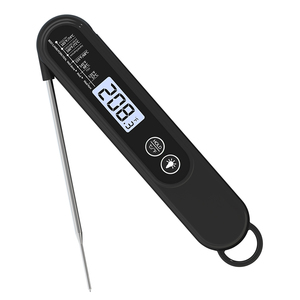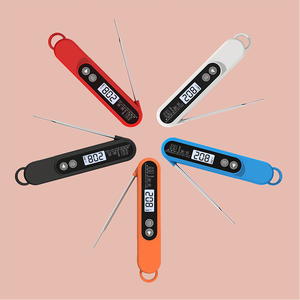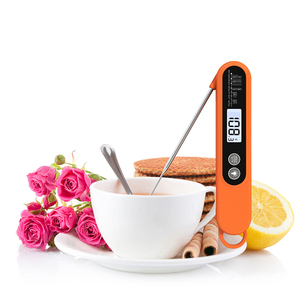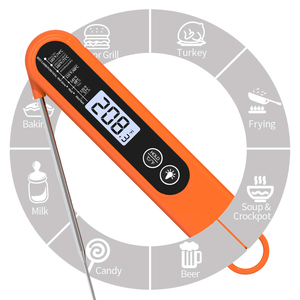(5970 products available)


























































































































































































































Food temperature probes come in distinct types. They include:
Instant-Read Probes
Usually, instant-read probes provide quick temperature readings. Normally, they have a slim probe that gets inserted into food to measure temperatures. Often, these probes deliver results in about 5-10 seconds. This ensures users do not have to wait long when checking on the preparation of meals. Commonly, these probes are ideal for grilling, roasting, and baking. In these applications, users need to perform quick checks on the temperature.
Wireless and Bluetooth Probes
Conventionally, wireless probes communicate with smartphones or dedicated receivers. This allows users to monitor temperatures from a distance without being physically present in the kitchen or near the grill. Moreover, Bluetooth probes work within a range of about 30 feet, while those with a Wi-Fi connection can transmit data over greater distances. These are mostly preferred for outdoor cooking when users need to maintain a certain distance from the grill.
Dual-Sensor Probes
Usually, dual-sensor probes allow simultaneous monitoring of two meats or one meat and its cooking environment. Commonly, they are used with a digital display that shows both temperature readings at the same time. This feature helps in tracking the doneness of food and the ambient temperature in a cooking device. For example, smokers need a good temperature control.
Oven-safe Probes
Lately, oven-safe probes have been designed to withstand high temperatures. They are normally placed inside an oven or cooking appliance. These probes connect to a digital thermometer or a smart device, offering real-time temperature updates. Additionally, they are useful for people who need precise temperature control while baking or roasting meat.
Fork Thermometers
Usually, fork thermometers earn a living as multifunctional tools. They are designed to both pierce and measure the temperature of food. Instead of a separate probe, thus incorporating the temperature sensors into the fork tines. This design makes it practical for checking the doneness of food on plates or in grills. This provides quick and easy readings.
Food temperature probes have diverse applications. They include:
Food Manufacturing
The food industry employs these probes in various food temperatures in manufacturing. It ensures that food safety standards meet the regulatory requirements. These instruments are strategically used to measure the internal temperatures of cooked products, which are essential for verifying that harmful bacteria are eliminated. In addition, they make sure that the temperature control during food processing prevents spoilage.
Cold Supply Chain Monitoring
The measurement of temperature is vital for maintaining food safety in the cold supply chain. In addition, temperature probes monitor the storage conditions in warehouses, transportation trucks, and retail displays. They are responsible for ensuring that perishable products such as dairy, meat, and produce remain within safe temperature ranges. Failure to do so may lead to foodborne illnesses. Therefore, businesses can avoid costly product spoilage and recalls by incorporating probes into their supply chain management.
Restaurant and Catering Services
Restaurants and catering services manage food temperature with great importance to ensure customer safety and satisfaction. These industries incorporate temperature probes to check the doneness of meats, verify that hot foods stay above danger zones, and confirm that chilled foods are at safe temperatures before serving. In addition, traceability of temperature reads offers compliance with health regulations. Meanwhile, it reduces the risk of foodborne disease outbreaks. Additionally, efficient use of probes helps minimize waste caused by improperly cooked food.
Food Storage and Inventory Management
Temperature control is necessary in inventory management in food storage facilities. Usually, temperature probes are integrated into systems that monitor and record the storage conditions of perishable inventory in real-time. In addition, they help to generate alerts when temperatures go out of acceptable ranges. This proactive approach prevents food spoilage, saves financial resources, and ensures products remain in optimal conditions for consumer safety and satisfaction.
Agricultural Practices
The temperature probes play an imperative role in agriculture by verifying food safety before distribution. The farmers who raise livestock use probes to examine meat temperatures. This practice forms a barrier against foodborne pathogens. On the other hand, those who grow crops rely on temperature control to guarantee that produce remains fresh and reaches consumers in a healthy state. Moreover, both goods prevent wastage and secure public health.
Food temp probes have distinct key specs. They include:
Temperature Range
Usually, the temperature range allows food temperature probes to measure temperatures at extremes. In most cases, probes range from -50°C to 300°C. This makes them suitable for various cooking methods and food types. Additionally, a larger range provides versatility. Thus, it enables users to check temperatures for grilling, baking, deep frying, and more.
Response Time
The response time of a probe determines how fast it can provide an accurate temperature reading. Usually, it is a critical factor in fast-paced cooking environments. Normally, probes with a response time of 1-3 seconds are most efficient for instant readings. Furthermore, quicker response times reduce the likelihood of heat loss during cooking. Hence, it allows for more accurate and timely results.
Probe Length
Commmonly, the probe length which ranges from 10cm to 15cm offers varying depths for different food types. A longer probe is ideal for large cuts of meat or thick dishes. Meanwhile, a shorter probe works well for smaller foods or liquids. In addition, suitable length ensures that the temperature is measured accurately without affecting the integrity of the food.
Wireless Connectivity
Mostly, many modern food temperature probes come with Bluetooth or Wi-Fi connectivity. They enable users to monitor temperatures remotely via smartphones or digital displays. This feature offers convenience for long cooking processes. It allows users to receive alerts and updates without being tethered to their kitchens. Hence, they can partake in other activities when their food attains the desired temperature.
Waterproof Design
Temperature probes for food are often designed to be waterproof or water-resistant. This makes them easy to use in messy environments. For instance, grilling or baking. Moreover, waterproof probes allow for easy cleaning after use. Moreover, they ensure the device remains durable even after exposure to liquids or steam.
When choosing food temperature probes buyers ought to consider various factors. They include:
Accuracy and Precision
Food temperature probes have to provide readings close to the actual temperatures to ensure food safety. Buyers should settle for models with a small margin of error. Also, those with quick response times will instantly reflect changes in temperature. In commercial settings, where consistency is vital, precision enables chefs to replicate results.
Durability
Typically, probes constructed from stainless steel are preferred due to their sturdiness and resistance to rust. Probes normally endure a busy kitchen environment. Therefore, their materials should be able to withstand frequent usage and sometimes unintentional drops. Also, a sturdy probe tip helps with rigorous tasks like checking the temperature of big cuts of meat.
Temperature Range
Buyers should identify probes that can measure a broad temperature range. Thus, making them adaptable to several cooking processes. For example, roasting, smoking, or candying. Also, probes that withstand extreme heat cater to users who engage in high-heat cooking techniques.
Ease of Use
Buyers should identify temperature probes with digital displays that are easy to read. For instance, large, light screens, and simple controls. Probes that come with a stand or clips keep them hygienic and accessible. In addition, models that feature a wireless option enable users to monitor food temperatures from a distance seamlessly.
Versatility
Some temperature probes come with multiple functionalities. For instance, those with timers or alarms enhance their efficiency in food preparation. Probes that concurrently monitor various foods offer users more flexibility while cooking. Additionally, temperature probes that integrate with mobile applications offer personalized template options. This makes food temperature management easier and more efficient.
The food temperature probes check food temperatures to avert food contamination. Additionally, they manage medication temperatures to ensure efficiency during processing. Moreover, they verify the temperatures of refrigerated and frozen food to enhance safety and quality. Also, they are used in scientific research labs to monitor samples. That aside, they check the temperatures of hazardous substances and liquids during transportation. It helps quickly detect any temperature anomalies. More importantly, temperature probes are useful for measuring the internal temperature of cooked meats. This ensures they are safe for consumption.
Temperature probes are increasingly becoming Bluetooth-enabled to boost efficiency. This allows users to monitor cooking temperatures without necessarily being in proximity to the food. Some models can withstand around 200 degrees of heat, making them ideal for grilling or oven use. Also, certain probes feature a smart alarm. Therefore, users can set a desired temperature, and a beep will notify them upon completion. In addition, probes with a built-in timer aid in tracking cooking time. That aside, temperature probes featuring an LCD screen for quick reading are available.
In general, buyers should focus on at least understanding their potential clients' preferred probe type. They should also identify temperature probe models with distinct mechanisms and features. More importantly, they should focus on temperature probes that come with several industrial applications. Buyers should partner with reputable suppliers to secure quality temperature probes. Also, they should buy in bulk to benefit from price discounts. When buying online, they should place orders from reliable websites. Finally, before buying food temperature probes, they should consider the market and avoid making impulse purchases.
Food temperature probes are durable. However, some parts may wear out with regular use. The most vulnerable part is the probe tip. This is because it directly penetrates foods. Frequent usage may lead to bending, corrosion, or loss of sharpness. Therefore, making it less effective in taking accurate readings. Probes can also wear out due to moisture. When moisture gets into the probe, it affects the electronics inside. Probes that constantly get wet will have reduced accuracy over time. Hence, it is recommended to replace them regularly.